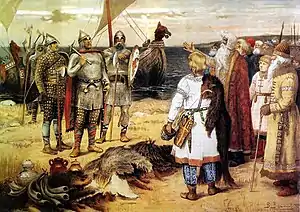| Sineus and Truvor | |
|---|---|
 | |
| Reign | 862–864 |
| Dynasty | Rurik |
Sineus and Truvor (Russian: Синеус и Трувор)[lower-alpha 1] were the brothers of Rurik, a Varangian chieftain of the Rus' who is traditionally considered to be the founder of the Rurik dynasty. According to the Primary Chronicle, the brothers were invited by East Slavic and Finnic tribes to reign in northern Russia in 862.[2] Sineus established himself at Beloozero and Truvor at Izborsk.[2] After they died, Rurik consolidated their territories into his own.[3]
Description
According to the Primary Chronicle, compiled in c. 1113,[4] a group of Varangian Rus' were invited to rule over the local East Slavic and Finnic tribes after they began fighting each other.[5] Rurik, the oldest of the brothers, established himself in Novgorod, while Sineus established himself at Beloozero, on the shores of Lake Beloye, and Truvor at Izborsk,[6] although archaeological findings have also suggested that his residence was in Pskov.[7] Truvor and Sineus died shortly after the establishment of their territories,[8] and Rurik consolidated these lands into his own territory,[9] thus laying the foundations for the state of Kievan Rus'.[10]
According to popular 20th-century scholarly interpretation (summarized in the textbook by Katsva and Yurganov),[11] the phrase "Rurik, Sineus, en Truvor" should be read "Rurik, sine hus, en tro(gna) vär(ingar)" (Rurik, his house/relatives, and true companions).[12] However modern linguistical expertise shows[13] that "sine hus" and "thru varing" contradict basic morphology and syntax of known old Scandinavian dialects, and could never be translated as "our faithful" and "his households". On the other hand, historians of the 19th century (A. Kunik, N. Belyaev, et al.) had already found common old Scandinavian names such as Signjótr (also Sveinn?) and Þórvar[ð]r, which could fit well with "Sineus" and "Truvor" by Nestor's transcription.
See also
Notes
- ↑ Church Slavonic: Синеусъ и Труворъ[1]
References
- ↑ Polnoe sobranie russkikh letopiseĭ (in Russian). Izd-vo Akademii nauk SSSR. 1851. p. 88.
- 1 2 Peterson, Gary Dean (21 June 2016). Vikings and Goths: A History of Ancient and Medieval Sweden. McFarland. p. 209. ISBN 978-1-4766-2434-1.
- ↑ The Oxford illustrated history of the Vikings. Oxford [England]: Oxford University Press. 1997. pp. 138–139. ISBN 9780192854346.
- ↑ Langer, Lawrence N. (2021). Historical dictionary of medieval Russia (Second ed.). Lanham. p. 145. ISBN 9781538119426.
{{cite book}}: CS1 maint: location missing publisher (link) - ↑ Dolukhanov, Pavel Markovich (2013). The early Slavs : Eastern Europe from the initial settlement to the Kievan Rus. Oxfordshire, England. p. 182. ISBN 9781317892229.
{{cite book}}: CS1 maint: location missing publisher (link) - ↑ The Scots magazine, or, General repository of literature, history, and politics. Printed by Alex Chapman and for James Watson. 1802. p. 339. Retrieved 19 August 2012.
- ↑ Wladyslaw Duczko (2004). Viking Rus: Studies on the Presence of Scandinavians in Eastern Europe. BRILL. p. 111. ISBN 978-90-04-13874-2. Retrieved 19 August 2012.
- ↑ Langer, Lawrence N. (2021). Historical dictionary of medieval Russia (Second ed.). Lanham. p. 176. ISBN 9781538119426.
{{cite book}}: CS1 maint: location missing publisher (link) - ↑ Gwyn Jones (19 July 2001). A History of the Vikings. Oxford University Press. pp. 246. ISBN 978-0-19-280134-0. Retrieved 19 August 2012.
- ↑ Thomas Schaub Noonan; Kathryn Reyerson (2006). Pre-Modern Russia and Its World: Essays in Honor of Thomas S. Noonan. Otto Harrassowitz Verlag. p. 161. ISBN 978-3-447-05425-6.
- ↑ Кацва, Л. А.; Юрганов, А. Л. (1996). История России VIII-XV вв (in Russian). Moscow: Вентана-Граф. pp. 21–22. ISBN 5708401028.
- ↑ Рюрик - Синеус - Трувор. Great Soviet Encyclopedia.
- ↑ Мельникова Е. А. (2000). Древнейшие государства Восточной Европы. 1998 г. Восточная литература РАН. pp. 148–149. ISBN 5-02-018133-1.